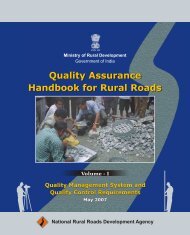Grameen Sampark Final April 0... - pmgsy
Grameen Sampark Final April 0... - pmgsy
Grameen Sampark Final April 0... - pmgsy
Create successful ePaper yourself
Turn your PDF publications into a flip-book with our unique Google optimized e-Paper software.
Where,<br />
-11 5.44<br />
N = 3.42 x 10 (1/ ) (11)<br />
N = Number of standard axle repetitions to<br />
cause 50 mm rutting;<br />
<br />
V<br />
= Vertical sub grade strain<br />
Performance criterion is the most important aspect<br />
considered in the design of pavements and all rational<br />
design methods must have properly developed<br />
performance criteria. It is seen that most of the design<br />
methods in vogue have design criteria mostly in terms of<br />
subgrade strain and aim to control rutting. The main<br />
concerns with the design practices followed in India are<br />
that either they do not have performance critferia or<br />
even if there is mention of performance criteria there is<br />
not much evidence of the criteria having been<br />
developed on the basis of sufficient data. This<br />
emphasizes the need for collection of data on the<br />
performance of different types of low-volume roads on a<br />
long term basis. The recent initiative taken by NRRDA<br />
for collection of performance data on the recently<br />
constructed PMGSY will go a long way in filling this<br />
major void in the low-volume road design in India.<br />
References<br />
1. American Association of State Highway and<br />
Transportation Officials, “AASHTO Guide for<br />
Design of Pavement Structures 1993, AASHTO,<br />
Washington, D.C.<br />
2. Austroads Pavement Research Group 1998, A<br />
guide to the design of new pavements for light<br />
traffic: a supplement to Astroads pavement design,<br />
APRG Report No. 21, ARRB Transport Research,<br />
Vermont South, Victoria.<br />
3. Austroads, Pavement design a guide to the<br />
structural design of road pavements, AP-17/92,<br />
Austroads, Sydney, 1992.<br />
4. Vermont Agency of Transportation, “Low Volume<br />
Pavement Design Procedure”, Vermont Agency of<br />
Transportation, Montpelier, VT, March 2002<br />
V<br />
Pradhan Mantri Gram Sadak Yojana<br />
5. Ibid. Shook J.F., Finn F. N.., Witczak M. W. and<br />
Monismith C. L., “Thickness Design of Asphalt<br />
Pavements The Asphalt Institute Method, pp. 17-<br />
44.<br />
6. Lister N. W. and Powell W. D., “ Design Practice<br />
for Bituminous Pavements in United Kingdom”<br />
Proc. 6th International Conference on Structural<br />
Design of Asphalt Pavements”, Vol-1, 1987, pp.<br />
220-231.<br />
7. Gerristen A. H. and Koole R. C. “Seven Years'<br />
experience with the structural aspects of the Shell<br />
Pavement Design Manual”, Proc. 6th International<br />
Conference on Structural Design Asphalt<br />
Pavements”, Vol-1 1987, pp. 94-106.<br />
8. Indian Road Congress, IRC:37:2001 Guidelines<br />
for Design of Flexible Pavements, New Delhi,<br />
2001.<br />
9. Indian Road Congress, IRC:SP:20-2002 Rural<br />
Roads Manual, 2002, New Delhi.<br />
1<strong>0.</strong> Mohanty S. K., Reddy K. S. and Pandey B. B..,<br />
“Performance and Design of Village Roads”,<br />
Highway Research Bulletin No. 55, IRC, 1996, pp.<br />
66-84.<br />
<strong>Grameen</strong> <strong>Sampark</strong> 21

















